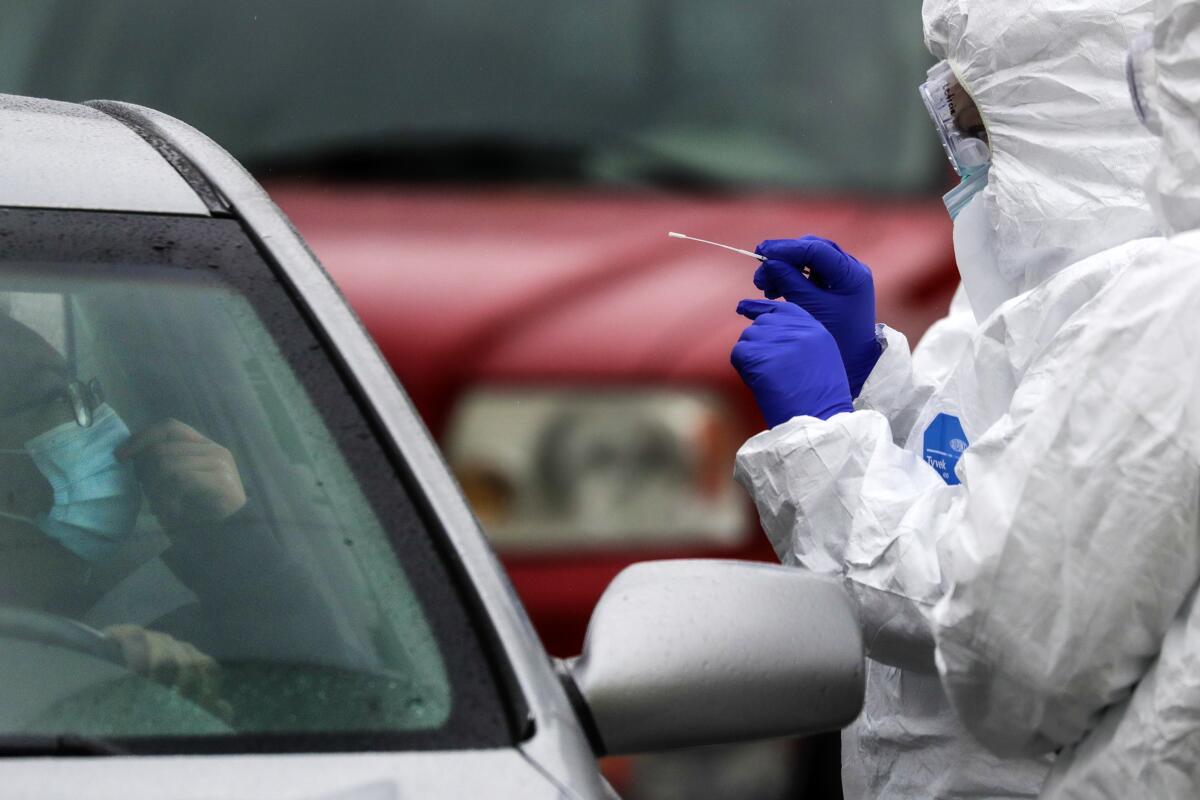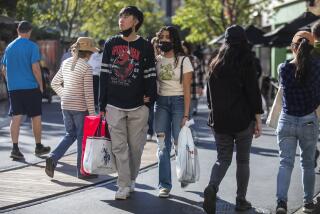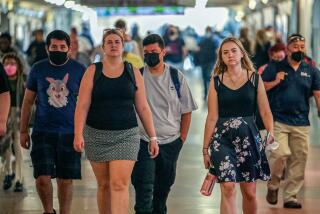Los Angeles County tops 5,000 coronavirus deaths

Total deaths from COVID-19 topped 5,000 in Los Angeles County on Tuesday, in what officials are calling a “heartbreaking” milestone for a health and economic crisis that won’t disappear anytime soon.
The county on Tuesday confirmed 63 deaths and 1,440 new cases of COVID-19, bringing the totals to 5,057 deaths and 211,808 cases since the outbreak began.
“This is heartbreaking and reminds us of the human toll of this pandemic,” said Dr. Barbara Ferrer, the county health director. “One of the deaths we are reporting today is of a young adult under the age of 29. This is a reminder that the risk for all of us is real and that no matter how young you are, this virus can be deadly.”
Like the statewide totals, Los Angeles County’s latest figures are incomplete and do not include results from all labs, officials said. Cases that are unaccounted for do not affect Los Angeles County’s reporting on key outbreak indicators, such as the number of hospitalized patients: 1,524, with 32% in intensive care.
On Monday, Gov. Gavin Newsom and other state officials held a press conference announcing that they’d cleared up a backlog of 250,000 to 300,000 test results dating from July 25. The confirmed cases from those backlogged tests will be included in statewide daily totals through the week.
To that end, California on Monday reported 13,149 new COVID-19 cases, with additional older results expected to increase daily totals throughout the week.
“The issue with the state’s electronic laboratory reporting system has been addressed, and the system is now performing as expected,” the California Department of Public Health said in a media statement Monday. “The entire backlog has been completely eliminated, and new cases attributed to the backlog will be reported over the next few days.”
Without an accurate picture of confirmed cases in recent days, many local officials who relied on the system had to conduct their own tallies to understand how the virus was spreading in their communities. The infection rate is a closely watched indicator for counties looking to reopen businesses and schools.
The Central Valley is currently the hardest-hit part of the state. Infections are spreading rapidly in Kern County, where there are now more than 1,000 cases per 100,000 residents, and Merced County, where there are 827 cases per 100,000 residents. Both counties have banned outdoor gatherings as a result. By comparison, Los Angeles County has about 340 cases per 100,000 residents.
In Northern California’s Lake County, where there are slightly more than 100 cases per 100,000 people, one of the state’s reopening thresholds, the testing backlog resulted in some extra computer work for nurses, but not much else.
“We’re so small that we pretty much get the data, the relevant data, straight in, and the state data is almost a backup for us,” said Lake County Public Health Officer Gary Pace. “We’ve been on top of it all along … I think a bigger problem would’ve been if we missed cases or some contact tracing.”
Another looming concern, Pace said, is wildfire season. The county has a history of devastating fires, and though COVID-19 case numbers are relatively low, they could spike if people are forced to shelter together to avoid a wildfire.
“There’s a huge history of wildfires here, and the biggest deal is preparing for the evacuation shelters,” he said.
State officials provided more details on the data glitches at a news conference Monday, saying the reporting delay could be traced back to a server outage on July 25 within the state’s tracking system, the California Reportable Disease Information Exchange, or CalREDIE, that kept 250,000 to 300,000 test results from being uploaded.
The delays were exacerbated by decisions made behind the scenes, officials said, and on Sunday, the state’s director for the Department of Public Health, Dr. Sonia Angell, resigned.
“These things are unfortunate, but we are moving forward,” Newsom told reporters during a news briefing Monday in Sacramento. “I’m governor. The buck stops with me.”
With the data beginning to arrive, the state case total continues its climb. Overall, California has had 574,411 confirmed COVID-19 cases, more than any other state, and 10,468 coronavirus-related deaths, .
After officials discovered the data backlog, the state stopped adding and removing counties from its watchlist of areas experiencing higher rates of transmission. Inclusion on the list subjects the counties to more restrictions than parts of California with lower caseloads. Thirty-eight counties, representing 97% of the state’s population, are on the list.
Newsom said he was confident that the updated statewide data on the rate of positive coronavirus tests would “look favorable” and cited other public health indicators showing a 19% decline in COVID-related hospitalizations over the last two weeks.
That progress includes a 13% decline in admissions to ICUs, Newsom said. About 8% of statewide hospital patients are being treated for COVID-19, down from 9% last week.
A new California system could allow local public health officials to grant waivers to reopen some elementary schools if the surrounding counties meet state standards. Officials have said that counties with coronavirus transmission rates higher than 200 cases per 100,000 residents should not apply.
As hospitalization rates and ICU admissions fall, “more and more counties will have an opportunity to consider the waiver process and determine if it is the right thing” for local school districts, said Mark Ghaly, California’s Health and Human Services secretary.
Officials in Los Angeles County have said that no elementary schools will be allowed to reopen immediately. Teachers, administrators and other staff will be allowed to return to school buildings if they observe social distancing and wear face coverings, officials said.
Times staff writers Taryn Luna and Melody Gutierrez contributed to this report.
More to Read
Start your day right
Sign up for Essential California for news, features and recommendations from the L.A. Times and beyond in your inbox six days a week.
You may occasionally receive promotional content from the Los Angeles Times.









